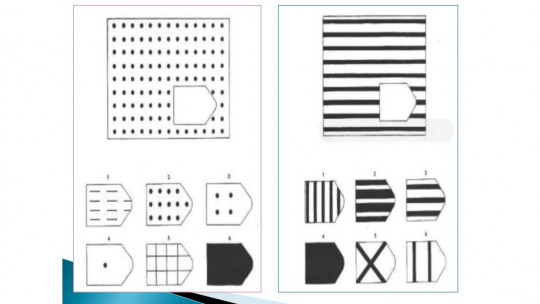
The Terman Merril Test (1916) is a tool for measuring intelligence, created by the American psychologist Lewis Madison Terman (1877-1956) and by the American psychologist Maud Amanda Merrill (1888-1978). This is a revision of the Binet and Simon test.
In this article we will see what this test consists of, what is its origin, what it evaluates and what are the 10 subtests that make it up.
What is the Terman Merril Test?
The Terman Merrill Test was born in 1916, by the two American psychologists mentioned at the beginning. This test is divided into 10 subtests, which include different types of tasks aimed at measuring both verbal and non-verbal intelligence.
In turn, the test can be divided into 6 large areas into which general intelligence is also divided:
The activities of the Terman Merril Test that make up these 6 areas are of different types, and through them Two values are obtained: the IQ and the degree of learning of the examined subject
Thus, the activities that make up the test include concentration tasks, analogies, judgments, abstract reasoning, memory, language, etc.
Origin
To understand a little about the history of the Terman Merril Test, let’s go to the origin of intelligence tests. These tests, also called intelligence tests, They have their origin at the end of the 19th century, by authors such as Alfred Binet and Théodore Simon (Binet was a psychologist and Simon, a psychiatrist).
Binet and Simon were the ones who developed the first intelligence test, which made it possible to determine the strengths and weaknesses in subjects’ cognition (that is, their intellectual abilities).
The Binet and Simon Test was used in numerous public schools, and many years later, Terman and Merril arrived, who revised the Binet and Simon test and adapted it so that its use was simpler and more effective
Features of this intelligence measurement tool
The Terman Merril Test consists of a psychometric test that evaluates intelligence and that allows determining the intellectual quotient of the examined subject through a series of subtests with different tasks, with a total duration of between 40 and 50 minutes (the full test).
Its use is intended for the evaluation of people who have a minimum educational level which allows them to understand the problems raised throughout the test.
As mentioned before, the test consists of 10 subtests that measure different abilities, all of them related to intelligence. Specifically, the test allows us to obtain two measurements: that of intelligence and that of learning capacity. Furthermore, also allows an interpretation of the scores and a diagnosis of the examined subject
From each of these measures (intelligence, learning capacity, interpretation and diagnosis) different scores are obtained, which refer to four values or ranges and which allow us to “classify” the subject in question. These values are five:
Aim
The objective of the Terman Merril Test is to measure a series of capabilities and abilities of the person, all of them related to general intelligence These capacities have to do with human cognition, and are intellectual capacity (general intelligence), analytical capacity, synthesis capacity and organizational capacity.
On the other hand, speaking of skills more related to practical intelligence, the test measures general culture, planning and decision making.
Finally, and in a more academic sense, the test allows you to evaluate skills such as numerical ability, verbal skills, comprehension and academic performance/achievement
Subtests
We have seen that the Terman Merril Test evaluates intelligence through 6 large areas (or specific factors), already listed. The test makes this evaluation through 10 subtests, which in turn include tasks and activities of different types; These consist of tests that evaluate both verbal and non-verbal intelligence.
Let us remember that verbal intelligence includes activities that require reading and understanding of language, and non-verbal intelligence does not (this second type of intelligence is more of abstract reasoning, evaluated through exercises such as “following the numerical series”). ). That is, non-verbal intelligence does not require that the subject know how to read.
Now, let’s see which 10 subtests make up the Terman Merril Test.
1. Information
The first subtest of the Terman Merril Test is information. This measures the subject’s long-term memory, as well as the level of information that the subject is able to capture from their environment
Their score indicates the person’s capacity for association when using data, as well as their ability to generate information through their knowledge.
2. Judgment or understanding
The second subtest evaluates the subject’s judgment or understanding. So, measures the person’s common sense, as well as their handling of reality Your score indicates the presence or absence of understanding and ability to solve practical (everyday) problems.
It also reflects the person’s degree of adjustment to social norms, and how he or she takes advantage of life experiences to learn.
3. Vocabulary
Also called subtests of verbal meanings, evaluates the presence or absence of abstract thinking, as well as the cultural level of the subject Specifically, it measures the subject’s knowledge of language, as well as the analysis that the subject makes of the different concepts.
4. Synthesis or logical selection
The next subtest of the Terman Merril Test is the synthesis one, and measures the subject’s reasoning, its capacity for abstraction and the deductions it makes through logic
Thus, through this subtest we can know the subject’s ability to interpret and evaluate reality objectively. It also analyzes the ability to summarize (synthesize), relate ideas and generate conclusions.
5. Arithmetic or concentration
This subtest evaluates to what extent the tested subject handles information, concentrates, and resists distractions In short, it tells us what degree of concentration (attention) the subject has when he or she should concentrate (especially under pressure).
6. Analysis or practical judgment
The following subtest evaluates common sense, foresight and the ability to identify inconsistencies. It allows determining whether the subject is capable of breaking down the information of a problem and explain its underlying causes.
7. Abstraction
The abstraction subtest of the Terman Merril Test, also called the analogies subtest, measures two fundamental aspects: understanding of information and the ability to generalize
That is, it allows us to analyze whether a person is capable of relating different ideas to reach a certain conclusion, and to what extent they can do so.
8. Planning
Also called the sentence ordering subtest, it evaluates the following skills: planning (i.e. planning), organization, anticipation, attention to detail and imagination
Thus, it determines the fact that the person is capable of foreseeing the consequences of certain actions, and also evaluates the ability to attend to the details and globality of a given situation.
9. Organization
The organization subtest, also called classification, measures the subject’s ability to discriminate and follow the processes It also evaluates whether an individual is capable of detecting failures in certain processes, and solving these failures.
10. Anticipation, attention or serialization
Finally, the last subtest of the Terman Merril test is that of anticipation, attention or seriousness.
Measure these capabilities, and their score indicates whether the subject is able to interpret and verify certain numerical calculations It also evaluates the subject’s ability to concentrate, especially under pressure.








